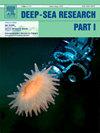巴西当前路径的时空变异性:来自卫星测高和全球再分析产品的诊断
IF 2.1
3区 地球科学
Q2 OCEANOGRAPHY
Deep-Sea Research Part I-Oceanographic Research Papers
Pub Date : 2025-03-01
DOI:10.1016/j.dsr.2025.104474
引用次数: 0
摘要
巴西海流(BC)表现出明显的时空变异性,在斜压不稳定和地形影响下,在本文章由计算机程序翻译,如有差异,请以英文原文为准。
Spatial and temporal variability of the Brazil current path: Diagnostics from satellite-derived altimetry and a global reanalysis product
The Brazil Current (BC) exhibits significant spatial and temporal variability, forming meanders and eddies off Cabo de São Tomé (22°S) and Cabo Frio (24°S) due to baroclinic instability and topographic influences. The BC presents considerable annual and interannual transport variability, affecting its trajectory and cross-sectional attributes. However, the connection between temporal variations in stream structure and its spatial distribution is often overlooked. This study investigates the long-term spatio-temporal variations of the position and structure of the BC between 21°S and 28°S, along the south-southeast Brazilian coast, using 28 years of altimetry and global reanalysis data. Results indicate that the width, depth, core velocity, and position of the BC are sensitive to transport changes, depending on latitude. The current path is more influenced by topographic gradients north of 24°S and less so to the south. At this latitude, the energy exchange between the mean flow and eddies correlates with transport increase, leading to a rise in downstream eddy kinetic energy (EKE) after two months. The BC intensification and path changes are influenced by broader phenomena, including the position and strength of the South Atlantic Subtropical Gyre, the wind stress associated with coastal upwelling (lagged by two months), and El Niño events (lagged by eight months). Rotated Empirical Orthogonal Function analysis at two cross-stream sites near Cabo Frio confirms that variations in strength and transport of the BC are key factors driving velocity variance, along with the growth of eddies due to baroclinic instability and the propagation of continental shelf waves.
求助全文
通过发布文献求助,成功后即可免费获取论文全文。
去求助
来源期刊
CiteScore
4.60
自引率
4.20%
发文量
144
审稿时长
18.3 weeks
期刊介绍:
Deep-Sea Research Part I: Oceanographic Research Papers is devoted to the publication of the results of original scientific research, including theoretical work of evident oceanographic applicability; and the solution of instrumental or methodological problems with evidence of successful use. The journal is distinguished by its interdisciplinary nature and its breadth, covering the geological, physical, chemical and biological aspects of the ocean and its boundaries with the sea floor and the atmosphere. In addition to regular "Research Papers" and "Instruments and Methods" papers, briefer communications may be published as "Notes". Supplemental matter, such as extensive data tables or graphs and multimedia content, may be published as electronic appendices.

 求助内容:
求助内容: 应助结果提醒方式:
应助结果提醒方式:


